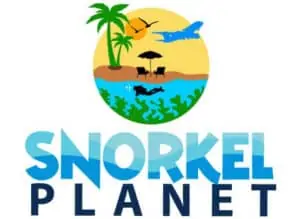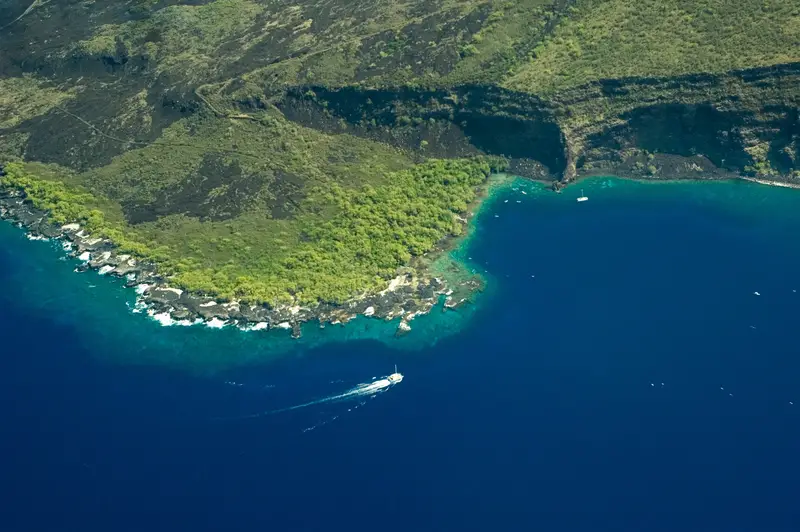
This article is part of our guide for snorkeling on the Big Island.
The Kona district is located on the Big Island (Hawaii) and covers a good amount of its western coastline. The area consists of North Kona and South Kona (we show you their combined location on the map below). In this article we share our 3 (by far) favorite snorkel locations in Kona. There are a few others that people seem to really love. We just share our personal preferences.
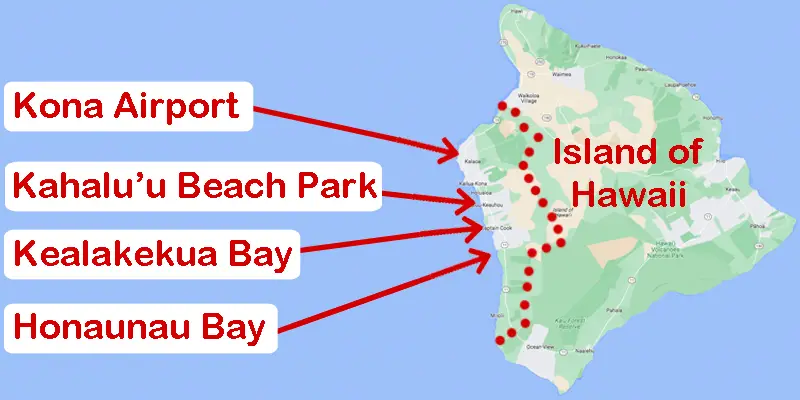
How to get there
Ellison Onizuka Kona International Airport is the main airport on the Big Island, located in the west. From there you could either hire a car, grab a taxi or use public transportation.
1. Kealakekua Bay
The picture at the very top of this page is in fact Kealakekua Bay. We decided to cover Kealakekua Bay first since (in our opinion) snorkeling in this spot is AMAZING! If you want to observe the most common Hawaiian reef fish surrounded by healthy coral, this is definitely where you want to go.
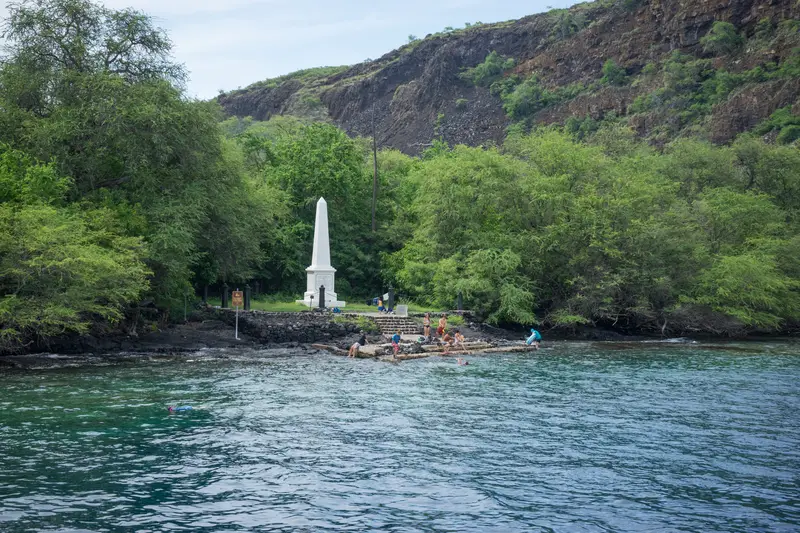
How To Get There
You have 3 options. However, the short answer is this: Your best option is to join a boat tour. Your first option is to hike the Ka’awaloa trail. Just be aware that this trail is quite a challenge for some of us and takes about an hour (one way). If you’re not a regular hiker it’s probably best to avoid this option. Furthermore, the road is partially rocky and sometimes even slippery.
Another option is to rent a kayak (there are several nearby companies available). We wouldn’t advise that either since Kealakekua Bay has no white sandy beach. In other words, you won’t be able to get rid of your kayak. So yes, you enter the water from your kayak and you need to climb back in once you’re done snorkeling. In the meantime you need to keep an eye on your little vessel so it doesn’t float away. Even though most people find a way to attach their kayak to their bodies (by rope for example), this is not what we call “relaxing”.
Your third (and in our opinion best) option is to join a boat tour. Sea Paradise offers various snorkel tours on their luxurious sailing catamaran. Not only will you be able to enjoy the lovely views of the Kona coastline, they’ll also drop you off right in the Kealakekua Bay marine sanctuary. All necessary snorkel equipment is included and their guide will even “snorkel you around”. Once you’re done you simply climb back aboard, grab a snack or drink and peacefully enjoy the scenery. Who knows you’ll even spot a few spinner dolphins!
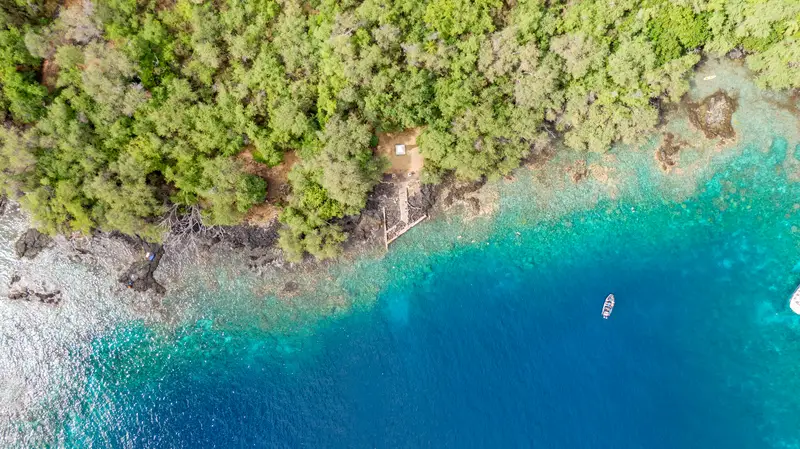
Snorkeling Near The Captain Cook Monument
The picture above is an aerial view of the Captain Cook monument in Kealakekua Bay. If you’re interested, more information about the monument can be found here. As you can see from the picture, there’s no sandy beach, so entering (and exiting) the water can be tricky. If you don’t mind the challenge, make sure to at least wear some water shoes for snorkelers because this is a rocky area. You can’t really go wrong when it comes to snorkeling. Simply stay close to the monument and you’ll be able to observe a fascinating marine life.
By the way, the water is crystal clear with perfect long-distance visibility. If you look at the above picture, you want to snorkel within the “turquoise” water that surrounds the monument. The video below shows you how shallow the area actually is. The water is usually calm, there’s a fascinating coral reef and you’ll be floating right above all the action! Unfortunately you won’t be the only one who tries to observe the marine life.
Kealakekua Bay is pretty popular, and rightfully so. However, don’t let the crowd stand in your way. There’s plenty of space for everyone and fish are literally everywhere. Even sea turtles enjoy this area so be prepared to spot a few along the coastline. Like we said, most of the typical Hawaiian fish species are present like for example parrotfish, triggerfish, butterflyfish, moorish idol, surgeonfish, wrasse and trumpetfish. Common corals include cauliflower, lobe and finger.
2. Kahalu’u Beach Park
Our second tip is to snorkel at Kahalu’u Beach Park. This area is located a little towards the north of Kealakekua Bay. Even though this spot has a little more sandy areas, we still consider it a rocky shoreline.
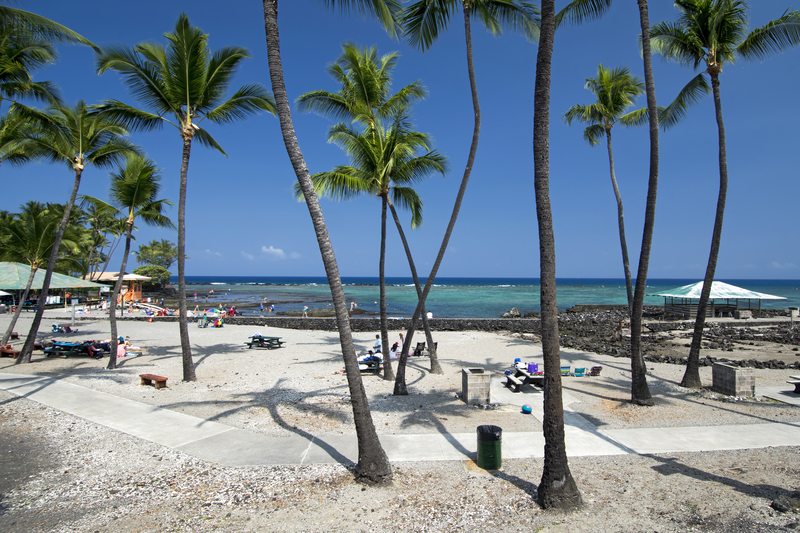
Entering The Water
The picture below should answer this question quite easily. However, there are a few tips we’d like to share with you. As you can see there’s a “passage” between various rock formations that leads towards the snorkel area. You’ll notice that the ocean floor within the passage contains a good amount of rocks as well, so make sure to bring a pair of water shoes.
Once you get closer to the ocean you’ll soon notice that the amount of sand below your feet increases. Don’t worry, the water is still shallow and you can still stand up straight easily. This is where we advise you to put on your snorkel gear. Pay attention to the orange buoys that float in the water. They indicate where the coral reef takes over. In other words, this is where you want to head out to and this is where you start to swim. The picture below clearly shows the difference between people standing and people snorkeling. In other words, you can’t go wrong when searching for that perfect snorkel spot.
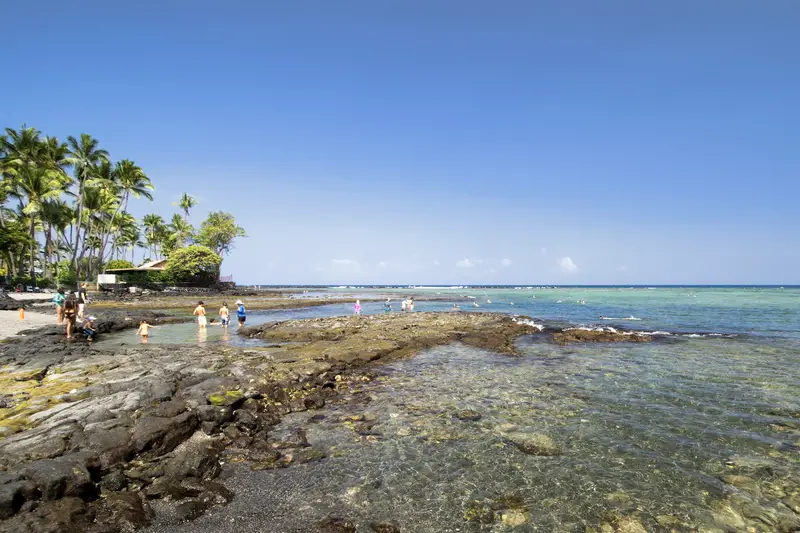
The Snorkeling Part
Now that you’re floating within the “snorkel area”, there’s still not a whole lot to observe. You need to swim out a little. Wherever you see other snorkelers, that’s probably where you want to head out to. It won’t take long before bigger rock formations cover the ocean floor and various fish species will grab your attention. As a simple guideline, if you stay within the shallow center of the beach you’ll be able to see most of the marine life.
Compared to Kealakekua Bay, Kahalu’u Beach Park has a somewhat less attractive ocean floor. However, don’t worry, because this is still a coral reef in the end. Even better, Kahalu’u Beach Park is protected by a number of reefs, which usually means comfortable water conditions. Beginners seem to also enjoy this location (as long as you’re able to walk through the passage and as long as you stay in shallow water). Again, this is a snorkel spot that contains most of the typical Hawaiian fish species.
Especially the large schools of yellow tang can’t be missed. But of course there’s more like for example parrotfish, triggerfish, butterflyfish, moorish idol and unicorn fish. Your chances to observe a sea turtle are a little smaller compared to Kealakekua Bay, yet they are definitely present. Typical corals include cauliflower and star. About the video below: Here’s a video that shows you the beach park, the water entrance and the marine life to expect. If you only want to check out the snorkeling part you can skip to the 2:40 minute mark.
3. Honaunau Bay (Two Step)
Important: We’ll keep this short and sweet since we already covered this location in a separate (full) review called “Two Step snorkeling“. However, let’s give you a helpful summary.
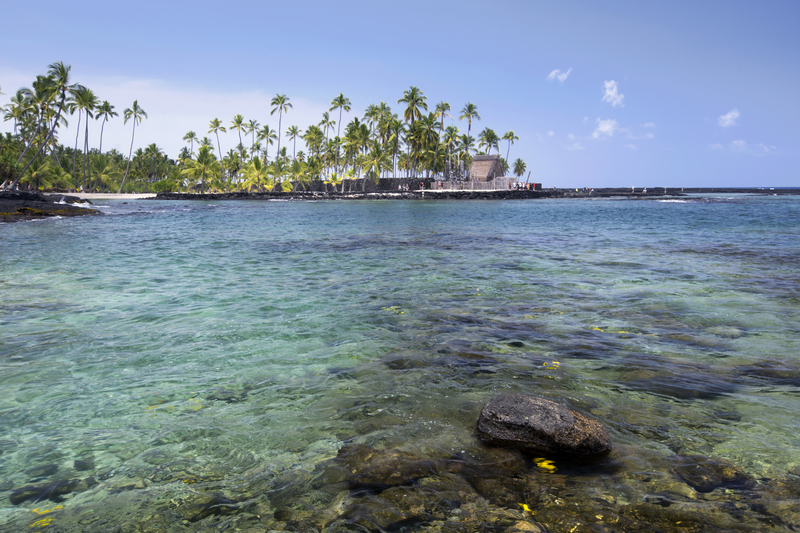
As you probably guessed, yes, this is another rocky bay with (again) a rocky water entrance. Just like the 2 previous locations, don’t let these rocks stand in your way to experience some amazing snorkeling. Sure, you need to be able to do a little “rock hiking“, but doing so is well worth the effort.
As the name already explains, you enter the water from 2 steps. In between all the lava rocks you’ll find 2 smooth and helpful “steps” that allow you to easily enter the water. You can compare it to entering the water from a small boat ladder, but of course, these steps are much bigger. The idea is to put on your snorkel gear on the second (lower) step, after which you simply enter the water. Just like Kahalu’u Beach Park, if you stay close to the shore you’ll be just fine in regards to the marine life.
This is another shallow snorkel spot with depths ranging somewhere between 6 and 15 feet (even though deeper areas are present, up to 25 feet). The coral is very healthy in this spot, and yes, this is another location to observe sea turtles. We suggest you read our full review from the link above in case you want to know more.
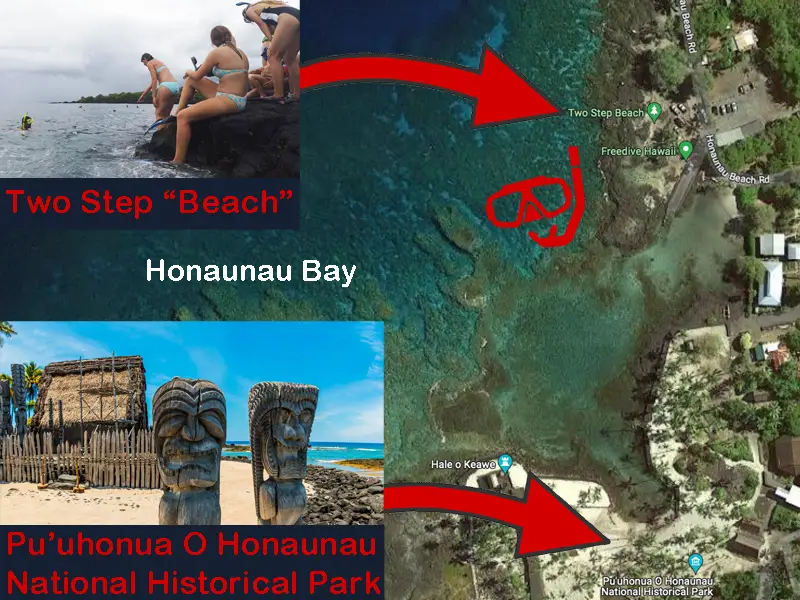
Excursion Tip: Manta Ray Night Snorkeling
Growing up to 20 feet in width, manta rays are definitely one of the largest (and most appealing) Hawaiian animals. By the way, don’t worry, because these manta rays don’t have stingers and are therefore harmless to people swimming around. These animals are active at night when they feed on plankton. In other words, if you’re the adventurous kind of person, why not consider a manta ray snorkeling tour.
Sea Paradise
We talked about the amazing tours of Sea Paradise before (in the paragraph about Kealakekua Bay). They are able to take you to some of the best snorkel spots within the area. However, they also offer night snorkeling with manta rays in the so called “Manta Ray Village”. Even better, you don’t need to snorkel a whole lot since floating gear and an underwater light is provided. You simply hold on to the floating lights and watch the show right below. No wonder why this trip received several “Top ratings” from various travel agencies.
Here’s a video of what to expect. It’s only 2 minutes long so we suggest to watch it in order to understand what this excursion is all about. Wetsuits and snorkel gear will be provided. Here’s a direct link to the Sea Paradise manta ray snorkeling tour in case you want to learn more (or even book a ticket).
Final Thoughts
Snorkeling in Kona on the west coast of the Big Island is usually not very easy to access, but the marine life makes up for it big time. If you want to snorkel at Kealakekua Bay your best option is to join a boat tour. Kahalu’u Beach Park and Two Step Beach are easier to access, but you still need to walk over quite some lava rocks in order to actually snorkel in these 2 locations.
The manta ray night snorkel tour is more than worth it for people who long for a little adventure. If you ever make it to the Big Island of Hawaii, consider to also snorkel at Black Beach on the southeastern shore. With its black sand and green sea turtles, this spot is definitely unique and worth a consideration.
